
Original Link: https://www.anandtech.com/show/1673
ATI's Radeon X800 XL 512MB - A toe in the 512MB pool
by Anand Lal Shimpi on May 4, 2005 9:27 AM EST- Posted in
- GPUs
At the end of last year, ATI announced 5 new GPUs, three of which were supposed to be available within a week of the announcement, none of which actually were. One of those GPUs, the X800 XL, was of particular interest as it was ATI's first real answer to NVIDIA's GeForce 6800GT and ATI said that it would be priced a full $100 less than NVIDIA's offering. Of course, that GPU didn't arrive on time either. And when it did, you had to pay a lot more than $299 to get it.
Fast forward to the present day and pretty much everything is fine. You can buy any of the GPUs that ATI announced at the end of last year at or below their suggested retail prices. But, we have another GPU release on our hands, and given ATI's recent track record, we have no idea if we're talking about a GPU that will be out later this month as promised or one that won't see the light of day for much longer.
Today, ATI is announcing their first 512MB graphics card - the Radeon X800 XL 512MB. Priced at $449, ATI's Radeon X800 XL 512MB is identical in every aspect to the X800 XL, with the obvious exception of its on-board memory size. The X800 XL 512MB is outfitted with twice as many memory devices as the 256MB version, but ATI is indicating that there's no drop in performance despite the increase in memory devices. The clock speeds of the X800 XL 512MB remain identical to the 256MB version, at 400MHz core and 980MHz memory. The 512MB version is also built on the same 0.11-micron R430 GPU as the 256MB version; in other words, the GPUs are identical - one is just connected to twice as much memory. Right now, the X800 XL 512MB is PCI Express only.
The board layout and design hasn't changed with the move to 512MB. The power delivery circuitry is all the same. The difference is that now there are twice as many memory devices on the PCB.
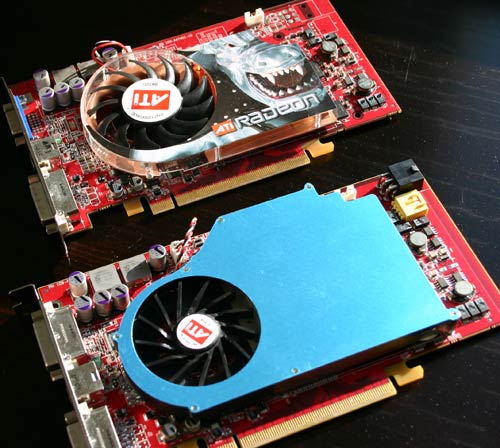
The two X800 XLs: 512MB (lower), 256MB (upper).
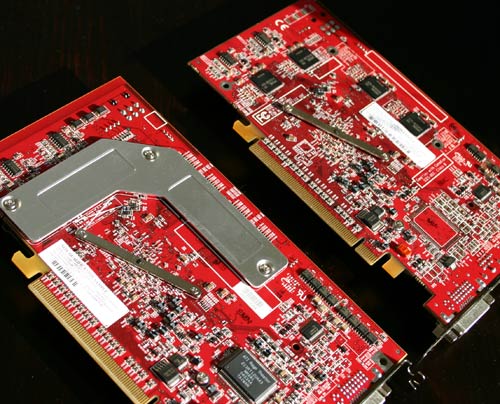
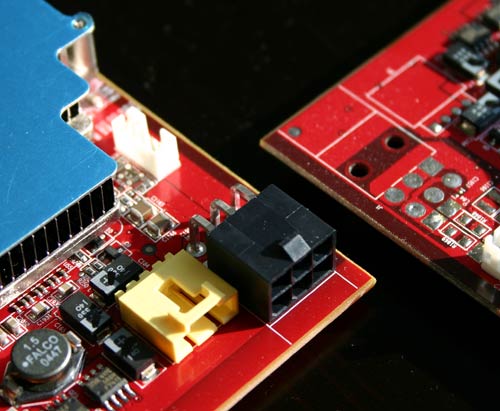
The X800 XL 512MB also now requires the 6-pin PCI Express power connector, something that the original 256MB board didn't need.
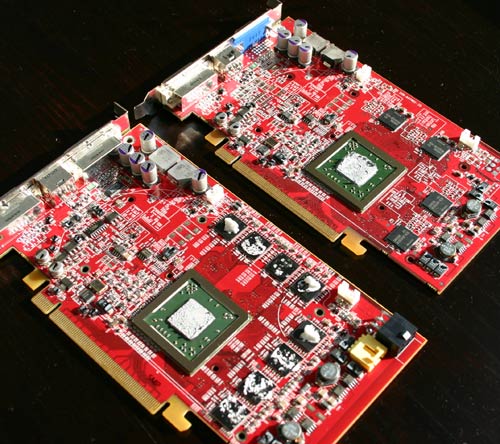
The X800 XL 512MB achieves its memory capacity by using twice the number of chips as the 256MB version.
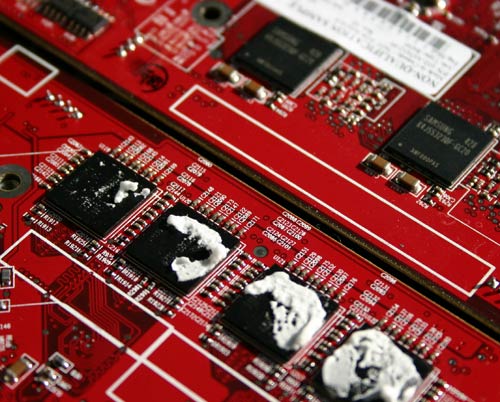
This is where ATI's strategy doesn't seem to make much sense. They are taking a mid-range performance part, the X800 XL, and giving it more memory than any of their GPUs, thus pricing it on par with their highest end X850 XT. More than anything, ATI is confusing their own users with this product. Those who are uninformed and have a nice stack of cash to blow on a new GPU are now faced with a dilemma: $449 for a 512MB X800 XL or $499 for a 256MB X850 XT? That is, if this part does actually ship to market in time and if it is actually priced at $449 - both assumptions that we honestly can't make anymore given what we've seen with the past several ATI releases.
What's also particularly interesting about today's 512MB launch is that ATI won't be producing any 512MB X800 XL cards under the "built by ATI" name. You will only be able to get these cards through ATI's partners. According to ATI, the following manufacturers will bring the X800 XL 512MB to market sometime this month:
- GigabyteAnd as confirmation, here's a slide from ATI's presentation saying the exact same thing:
- TUL
- Sapphire
- HIS
- MSI
- ABIT
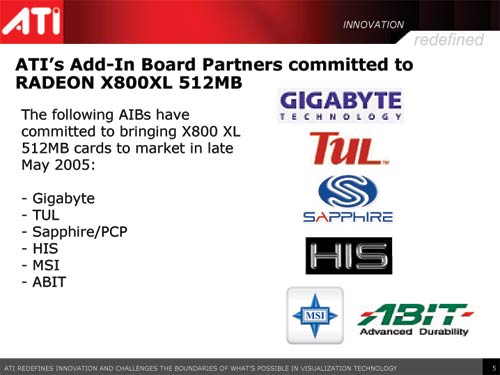
It is worth noting that NVIDIA has been shipping a 512MB card, the 512MB GeForce 6800 Ultra, for quite some time now. However, the card itself only seems to be available to system builders such as Alienware and Falcon Northwest. The 512MB 6800 Ultra is extremely expensive and appears to add around $800 to the cost of any system built by those who carry it; obviously, not in the same price range as ATI's X800 XL 512MB. Despite our curiosities, we could not get a card from NVIDIA in time for this review, although we'd be willing to bet that our findings here with the X800 XL 512MB would apply equally to NVIDIA's 512MB GeForce 6800 Ultra as well.
256MB vs. 512MB - The Real World Performance Difference
More local GPU memory is never a bad thing, but it must be taken advantage of to be worth its high cost. That means we need games with larger textures and higher detail levels to truly require 512MB cards, but given that the majority of gamers still have 64MB or less on their graphics cards - it's going to be a while before 512MB is necessary. Game developers are notorious for developing "for the masses" and thus, will spend very little time on that which can only be taken advantage of by owners of $500+ graphics cards, today's 512MB card included.ATI's own marketing literature claims that the X800 XL 512MB offers up to a 40% performance increase over the 256MB X800 XL...at 1600 x 1200, with 6X anti-aliasing and 16X anisotropic filtering enabled. The problem is that at such high resolutions with AA/AF cranked up, the X800 XL doesn't have the fill rate or the memory bandwidth to offer reasonable frame rates in most games, which is why we find the X800 XL 512MB to be more of a mismatch than anything else. A faster GPU with more memory bandwidth would be able to offer more real world benefit when coupled with 512MB of memory than the X800 XL.
That being said, let's look at the performance breakdown for the X800 XL 256MB vs. X800 XL 512MB at 1600 x 1200 with 4X AA and 8X AF enabled - pretty aggressive settings for the X800 XL to begin with.
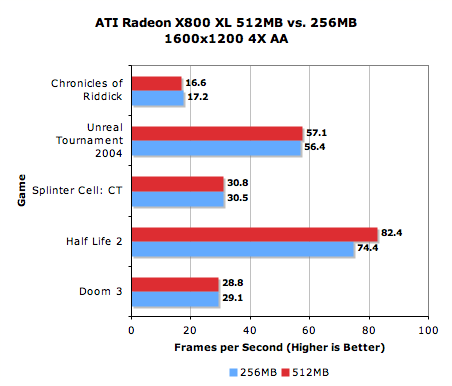
The Half Life 2 performance boost is particularly interesting, but that was the only game we encountered where the performance boost was not only reasonable, but the game was also fairly smooth in actual game play. However, at the price of the X800 XL 512MB, you are better off just purchasing an X850 XT and getting better performance across the board, including Half Life 2.
Although the single graph on this page pretty much tells the story of the X800 XL 512MB, we've included performance results from both X800 XL cards, the X850 XT as well as NVIDIA's GeForce 6800GT and 6800 Ultra on the coming pages, if you want to see things in perspective. We included the X850 XT and 6800 Ultra in the comparisons because it is priced similarly to the X800 XL 512MB's suggested retail price.
The Test
AMD Athlon 64 ConfigurationAthlon 64 4000+ Socket-939 CPU
2 x 512MB OCZ PC3200 EL Dual Channel DIMMs 2-2-2-10
ASUS nForce4 SLI Motherboard
ATI Catalyst 5.4 Drivers
NVIDIA 71.89 Drivers
Doom 3 Performance
For our Doom 3 tests, we ran using Ultra Quality settings, which can use upwards of 500MB of textures - in theory, making this a good benchmark for the X800 XL 512MB. 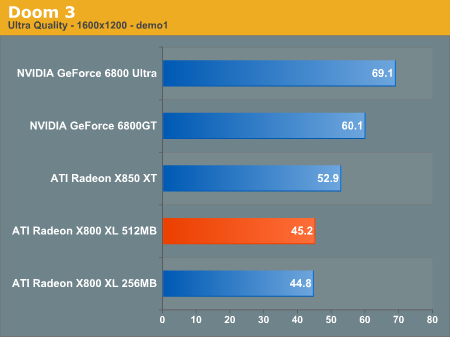
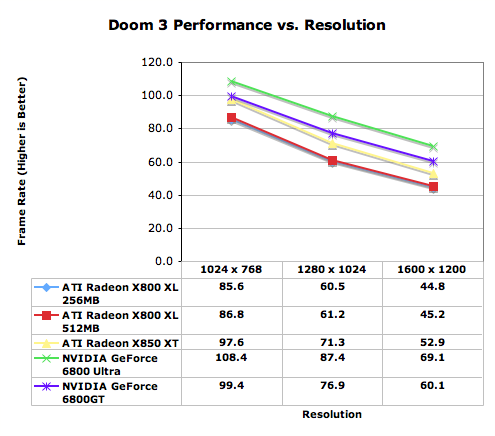
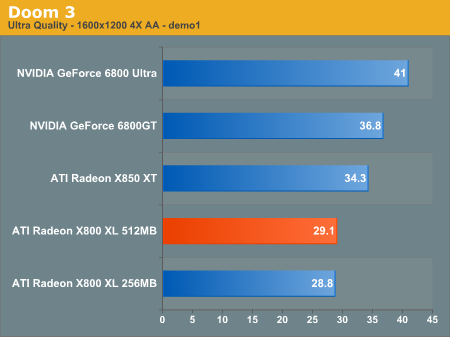
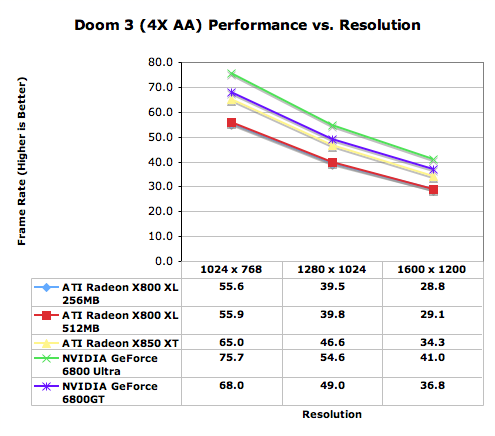
Splinter Cell: Chaos Theory Performance
For our Splinter Cell tests, we used the game's built-in benchmark, but our tests were streamlined by using Reverend's benchmark scripts. All tests were run using the scripts' default high quality settings with Shader Model 1.1. 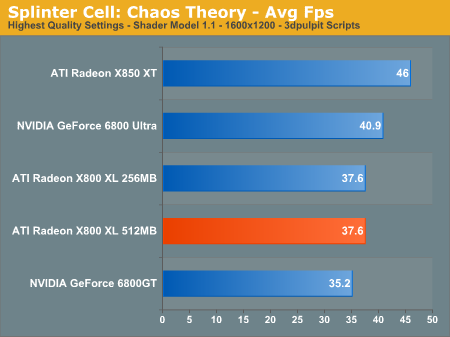
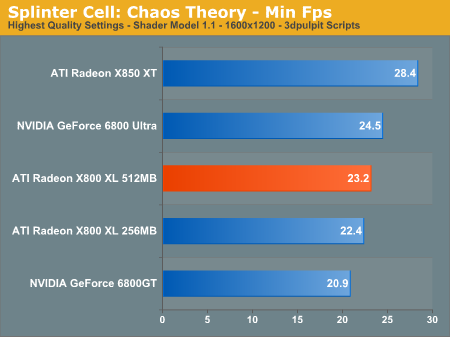
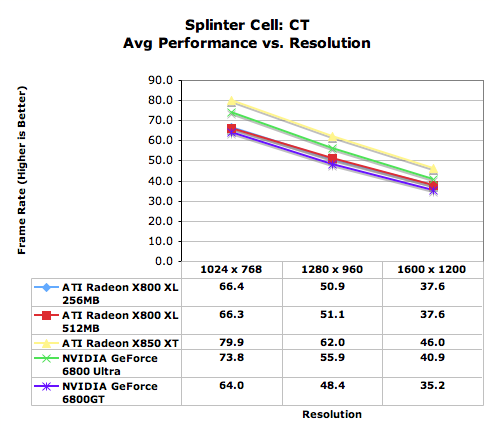
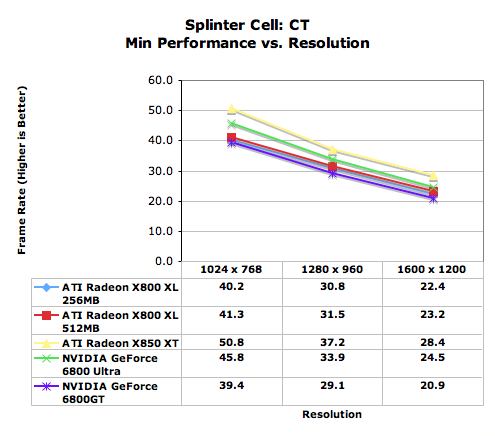
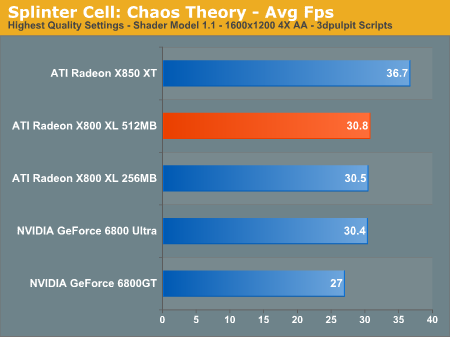
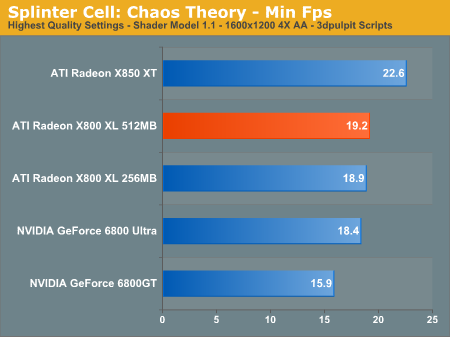
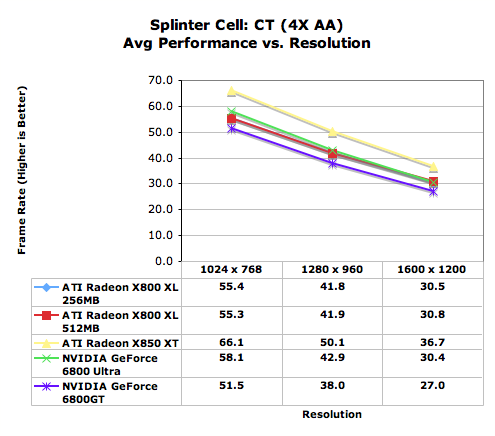
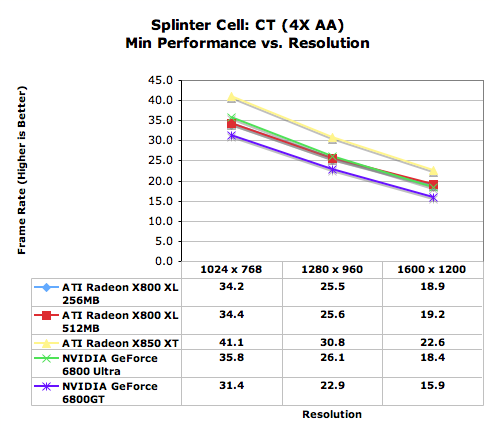
Chronicles of Riddick Performance
We recorded our own custom demo to measure performance under Chronicles of Riddick. 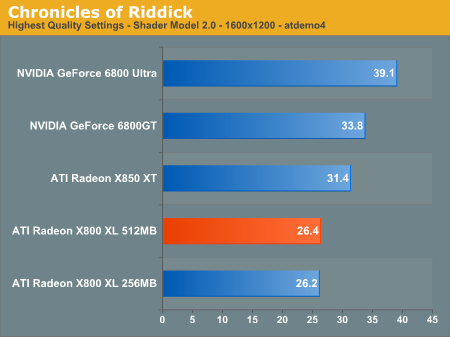
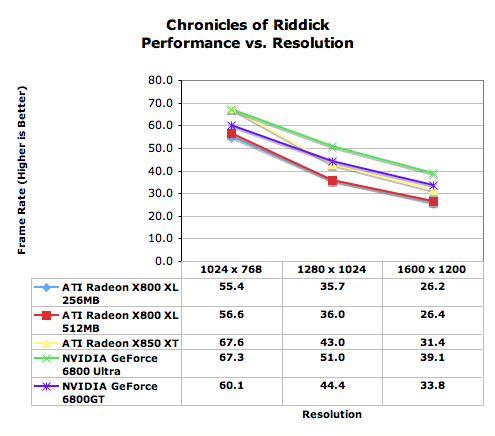
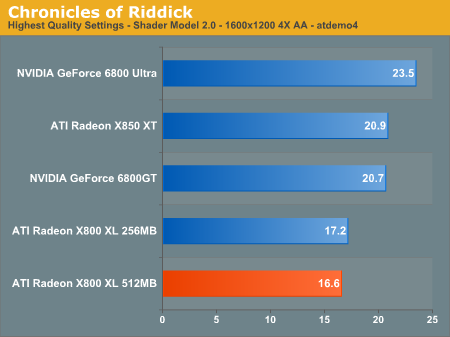
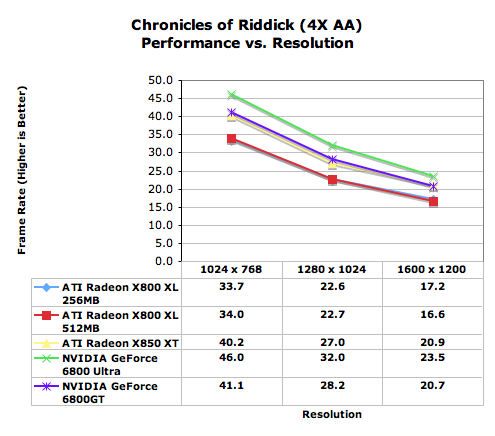
Half Life 2 Performance
For our Half Life 2 tests, we used our own at_canals_08-rev7 timedemo, with the same settings that we've used in the past for our Half Life 2 performance coverage. 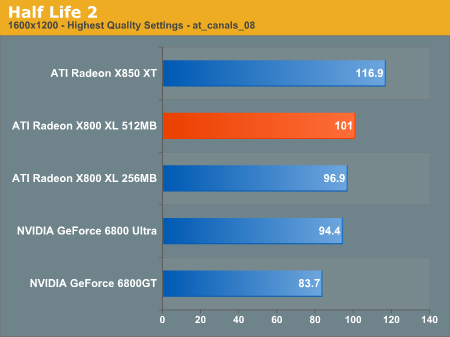
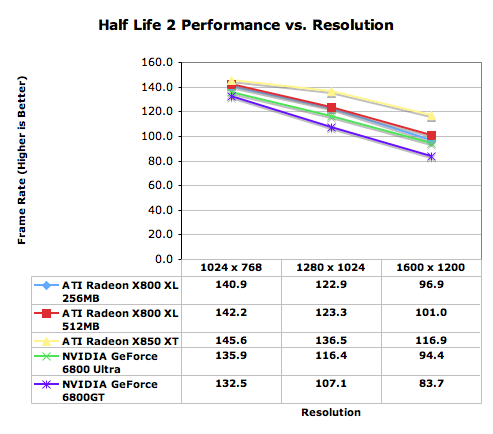
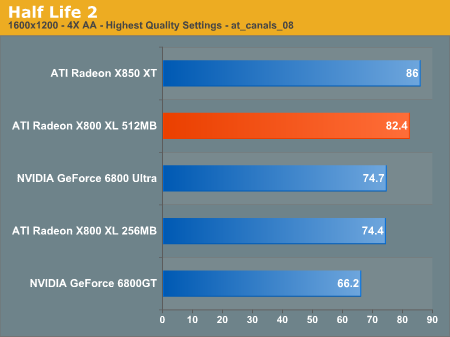
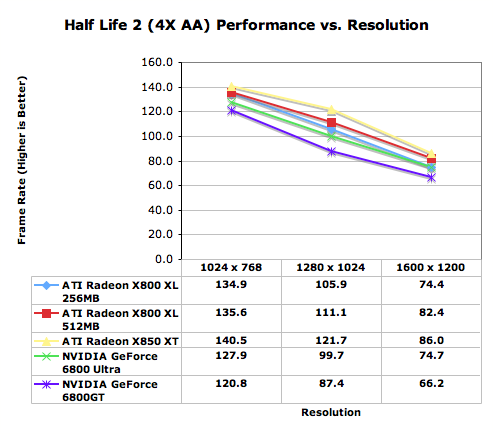
Unreal Tournament 2004 Performance
Once again, there's no performance increase attributable to the 512MB of on-board memory. 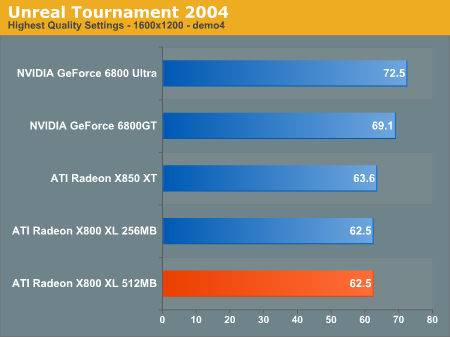
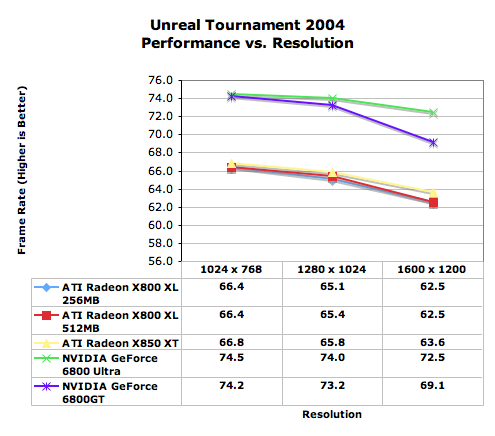
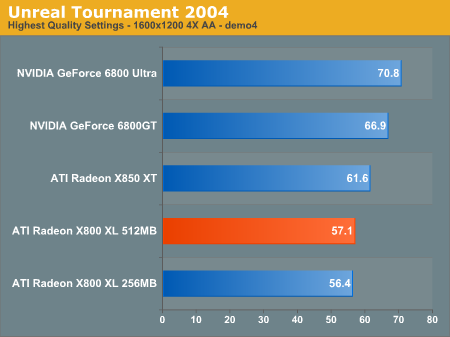
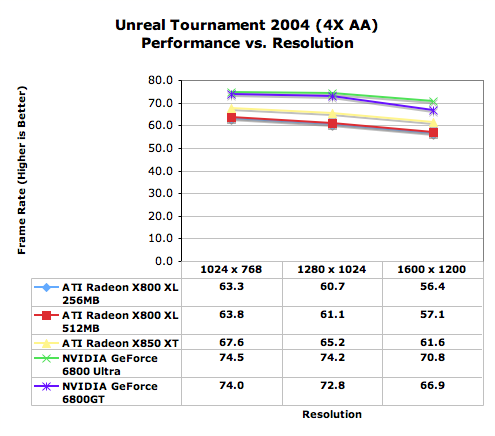
Final Words
Without a doubt, there will be a time when 512MB cards will be necessary. As we mentioned earlier, more local GPU memory is never a bad thing, it just has to be taken advantage of, and that time is not now.Performance across the majority of the games that we tested remained unchanged, even at their highest detail settings. We were a bit surprised that there was such a tangible benefit to the 512MB card running Half Life 2, but in the end, we attained better performance out of a similarly priced X850 XT with only 256MB of memory, even under Half Life 2.
ATI's desire to make their first 512MB part based on the X800 XL doesn't appear to make much sense either. The large amount of on-board memory would seem best fit for a GPU that was capable of running at resolutions and detail settings that would see some performance benefit from the additional memory.
We are worried that ATI doesn't have their users as Priority One, given the level of confusion that the X800 XL 512MB will insert into their product line. Without a significantly lower price tag, the new 512MB board inadvertently competes with ATI's X850 XT, which is clearly the better performer. With a 30% fill rate advantage, even in future games that do eat up more memory, we'd expect the X850 XT to still outperform the X800 XL 512MB. The fact of the matter is that developers aren't going to leave the majority of the gamers in the dark when it comes to implementing features and improving image quality. We wouldn't expect 512MB graphics cards to be the target for any development until the next generation of GPUs actually begins getting into the hands of gamers later this year. At that point, you're better off picking up a new GPU with more memory rather than one based on the year-old R42x architecture.
We can't help but feel a little puzzled by today's launch, but at the same time, very curious. Not so much about the X800 XL 512MB itself, but whether or not ATI will hold true to their word this time around. The X800 XL 512MB had better arrive later this month; otherwise, ATI will have just dug themselves a deeper hole and this time, it will have been for no actual benefit.







